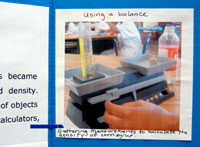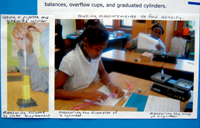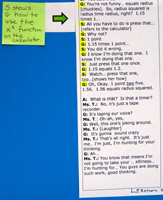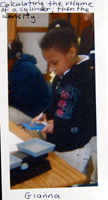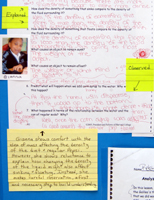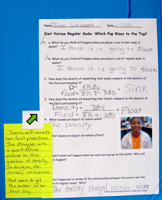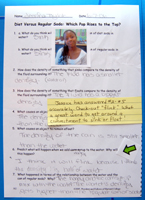Documentation Examples > Documentation Exhibition
Once is not enough: What effects can making thinking visible have on student learning?
School: Benjamin Banneker Charter School, Cambridge, MA
3. More Surprises
As they gained more experience, students became engaged in the measurement activities to find density. Students worked to find the mass and volume of objects and liquids.
They measured dimensions and used calculators, balances, overflow cups, and graduated cylinders.
Gianna and her partner worked together, discussing their measurements.
G: Oh no, that?s acrylic. I wonder if that?s the stuff they use on your nails. [Sounds of using a balance to find the mass.]
S: Put it on five, put it on five. ?Cm?on, cm?on. Ye-e-s!
G: You?re lucky?
G: So you think it?s going to float?
S: Uh?
G: You think it?s going to float?
S: That?s ____. No.
G: Let me see.
S: No
G: This is so light, though [sound of dropping cylinder]. This and wood are so light?
G: I think the acrylic one is going to float, too. All right, well, we?ll see, ? all right, so now we have to go through the volume again.
G: So?
S: [Sighs]
G: O.K. Let?s find the, let?s find diameter. And I?ll find the ?. No ?
S: 2.5 [then too soft to hear and pause]
G: La, la, la, I got 8. [Laughter] Yeah, you taking the bus? I got 2.5, too. All right, so 2.5, 2.5 is the diameter. 2.5 equals d. So now we have to do? All right, I want to see something real quick. Un oh, the wood was 2.3 for the diameter.
S: Wood ? 2.3.
G: All right, so this was 2.5. Hold on, I just have to?divided by?oh yeah. All right, so 2.5 divided by two?1.25.
S: Nooo, it?s 1.25.
G: That?s what I just said.
S: You said 1.25
G: You?re not funny? equals radius [chuckles]. So, radius squared is radius time radius, right? 1.15 times 1?
S: All you have to do is press that? [refers to the calculator]
G: Why not?
S: 1 point
G: 1.15 times 1 point?
S: You did it wrong.
G: I know I?m doing that one. I know I?m doing that one.
S: Just press that one once.
G: 1.15 equals 1.2.
S: Watch? press that one, too?[shows her how]
G: Oh, Okay. 1 point two five. 1.56. 1.56 equals radius squared.
For the first time, I saw ?consulting?. Jessica came over to them to ask about finding the volume of the cylinders. Gianna and her partner realized they still didn?t understand how to find volume well enough to explain it on their own.
Ms. T.: Do you need one like that?
J: No?
G: I know. Everyone is missing stuff.
J: I was asking something.
G: You can look at it, I don?t care.
G: All right, so?
J: Uhm, when you, when find the, umh
S: We, uh, one, uh got 2.5
J: When you figure out the... uhm
G: Are you talking to me?
S: The volume...
J: No, I wasn?t...
S: The volume...
J: Yeah, when you find it and then find that, what do you do? Do you multiply it?
S: With the height, with the height? What tcha do? What tcha do?
J: With the width and height? Do you multiply it?
S: Ooo?
J: Gianna,
G: Unh?
J: When you find the width and the height, do you, uhm, do you multiply it?
G: The width and the height?
S: ? same
G: That what she says. I don?t know.
J: To get the volume do you multiply?
G: We didn?t do that. She gave us this whole other thing.
J: What tcha do?
G: I don?t know. We had to do like, we had to convert into pi and all that stuff. Uh, I don?t even get a chance to show?
J: Did you figure out the volume?
G and S: Yeah
G: Like she made us change it up. A different way. I don?t know why.
Ms. T.: It?s the area of the base times the height.
S: Yes?
A: The area of the base times the height.
Ms. T.: Not just the width, the diameter, but the area. There?s that the formula.
J: Uh? She knows because that?s what you did.
G: I don?t know. I forgot. I don?t know it. Jessica, Can I see that thing real quick? I don?t know how I did it.
Students return to measuring and calculating for a minute or so before classroom teacher reviews the method for calculating volume.
Afterwards students continue with their work.
Some questions resulted in more evidence of student thinking than other questions.
Some students avoided the explanation parts of the questions.
While short answers revealed some thinking over time, looking at a collection work done over time revealed patterns of developing ideas I had not noticed before.

